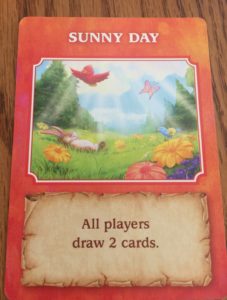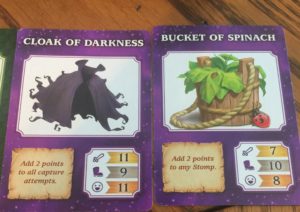Full disclosure – I really like this game. Like, more than my kids like it, like it.
I’d enjoy playing it with adults.
Playing with kids is a bit different matter, but read on.
If you are not familiar with the game, Dragonwood is a mixture of dice rolling, set collecting, risk-taking and probability – themed as though each player is a fantasy hero entering the Dragonwood forest to capture the dangerous beasts inside.
John-Gabriel – “You never know which cards you’ll get until you draw [reload] and I like getting the cards I need.“
Jacob – “Taking out the Dragons because they are really hard and you can fail even if you use a lot of cards/dice.“
The game’s main components are two decks of cards and a set of custom dice. The Adventurer deck is made up of numbered cards (1-12) of different colors and with card art of very traditional fantasy heroes (wizards, warriors, and rogues). To start the game, you are dealt 5 cards which make up your hand. As the game progresses you’ll turn cards in and get new ones.
 The Creature deck has a variety of fantasy monsters including Fire Ants, Angry Ogres, Grumpy Trolls and, of course, two Dragons. The creature deck also has environmental effect cards which causes each player to do something, like discard a card or pass a card to another player. It also contains special items that can be captured in the same way as creatures. These special items include A cloak of Darkness or a Bucket of Spinach and either give a permanent bonus to future capture attempts or a larger one-time bonus.
The Creature deck has a variety of fantasy monsters including Fire Ants, Angry Ogres, Grumpy Trolls and, of course, two Dragons. The creature deck also has environmental effect cards which causes each player to do something, like discard a card or pass a card to another player. It also contains special items that can be captured in the same way as creatures. These special items include A cloak of Darkness or a Bucket of Spinach and either give a permanent bonus to future capture attempts or a larger one-time bonus.

This is an example of an environmental effect that can be drawn from the encounter deck and effects all the players at the same time and then you draw a replacement card for it on the tableau.
The creature deck is the most complicated process of set up; First you remove the two dragons from the deck and then shuffle it. You then remove a number of cards (based on number of players) and set them aside, they are not used for that game. You then split the shuffled deck in two piles and add the two dragon cards to one half and shuffle it. You then combine the two halves by placing the non-dragon having half on top. This ensures that no one knows exactly which cards are coming up (because of the blind discard) and that the dragons don’t appear till late in the game. The game is over when both dragons have been captured OR you cycle through the adventure deck twice.
To start the game, you lay out the top 5 cards of the creature deck to form a tableau. As creatures are captured you replace them from the top of the deck. If you reveal an effect card, it triggers and is resolved and you then draw another new one and replace the recently captured creature’s spot.
On your turn you can take 1 of 2 actions; either attempt a capture or reload. If you attempt a capture you will trade in a number of the cards from your hand in exchange for the same number of dice. The more cards you turn in, the more dice you get with the goal being to match or beat the target number of the creature you are trying to capture.
The strategy here relates to their being 3 ways to attempt to capture a creature. You can Strike it, you can Scream at it or you can Stomp it.
Each creature card lists a separate resistance to each of these 3 capture attempt types and it’s often best to try and line up against their weakest defense, BUT the cards you turn in determine the type of attempt. If you turn in cards of the same color (so all blue, regardless of number) you are doing a Scream attempt. If you turn in cards of the same number (all 4’s, regardless of color) that is a Stomp attempt and if you turn in cards in sequential order (1,2,3,4,5,) regardless of color you are making a strike attack.

Two of the monsters you might encounter and try to capture. The number in the bottom left is it’s value. The numbers on the bottom right are the values you need to meet or exceed for each type of capture attempt.
You can turn in as few as 1 card or as many as 6 for the attempt and then roll that same number of dice. The dice are very beautiful (I’d love a full set of polyhedrons that look like these for my D&D games) being custom d6’s with one (1) side, two (2) sides, two (3) sides and one (4) side.

I really like the color of these dice. Would absolutely buy a full set if I could find them.
The risk taking vs. probability comes in with how many cards do you turn in? Do you want to use four dice to capture the Angry Ogre that is worth five points or risk it with three? It’s been interesting watching my boys approach this challenge from completely different directions. JG will often go after a creature with the minimum amount of dice even if he needs 4’s on all of them (so he fails a lot) where Jacob wants to roll lots of dice so he constantly turns in a lot of cards and easily passes but also ‘wastes’ cards meaning he is skipping several turns waiting to get more for his next capture attempt.
If you are attempting a capture you declare what you are trying to capture, how you attempting (Strike/Stomp/Scream), and then set the required cards aside. If you succeed those cards go into the discard pile and if you fail you keep those cards minus one you must discard for the failed attempt. If you don’t choose to attempt a capture you can ‘reload’ and draw a new card. There are lady bug cards that when drawn allow you to draw 2 additional cards.
One issue I’ve noticed is that as you get near the end of the creature deck and it’s obvious a dragon is going to come out soon, my kids will essentially start skipping their turns (reloading even though they already have their max nine cards and then discard the least useful ones) so they don’t use up cards they want to use against the eventually dragon. This allows me to capture low valued creatures very easily and cheaply and build up points (last game JG and I tied and he had both Dragons). They also play with their cards exposed so I can help them so they always know what the other person has (the lack of that knowledge would greatly increase the fun of this game I believe).
The first time we played it by these rules, the game lasted over 45 minutes. Some of that was learning the game, some of that was picking up the dice that kept getting thrown off the table, but a lot of it was skipping turns waiting to get enough cards to attempt a capture. I made a few adjustments to the rules to ‘fix’ that problem. Now when we play, when you attempt a capture (pass or fail) you get a new card to replace the one you lost and if you ‘reload’ you get 2 cards. This drastically picked up the pace of the game and made it much more enjoyable as you didn’t have 3 or 4 turns in a row where you were just ‘reloading’ after a big capture. I’ve read on-line of other alternate rules where you allow multiple capture attempts in a round as long as the player has cards to spend. I think given time this is a rule I’ll use, but for now because of how the boys play, allowing me to constantly pick up easy creatures, it would make me almost unbeatable.
The card art of the creatures is solid, if not epic. The special items are fun twists, though they can unbalance a game if the same person gets more than one early. I love the adventure theme. It’s basically a D&D game with capturehobos. The dice are really nice. All around this is a solid fun game – for me. At the moment the boys would much rather play Tsuro or King of Tokyo or Ticket to Ride than Dragonwood but I’m hoping that will change over the next few months.
Although my kids are a bit lukewarm on the game now, for only $14 bucks on Amazon I’m still recommending it as I enjoy it and I think shortly the boys will come to love it as much as I do and it’s also a fantasy themed, rules-light games which can be played with as few as 2 players (which isn’t always an easy find).
~ Michael
Purchase your copy of Dragon Wood here and help support our show!











1 pings